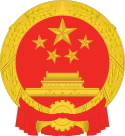State_councillor_(China)
State councillor
Senior position in the State Council of China
A state councillor (Chinese: 国务委员; pinyin: guówù wěiyuán) is a high-ranking position within the State Council, the executive organ of the Chinese government (comparable to a cabinet). It ranks immediately below the vice premiers and above the ministers of various departments. Similar to minister without portfolio, the position carries duties unspecified at the time of appointment, although state councillor may also be appointed to head a department.
| State Councillor of the People's Republic of China | |
|---|---|
| 中华人民共和国国务委员 | |
 | |
| State Council of the People's Republic of China | |
| Status | Sub-national leader level official |
| Member of |
|
| Reports to | Premier of the State Council |
| Residence | Zhongnanhai |
| Seat | Beijing |
| Nominator | Premier of the State Council |
| Appointer | President pursuant to a National People's Congress decision |
| Term length | Five years, renewable once consecutively |
| Formation | 4 May 1982; 41 years ago (1982-05-04) |
| Website | State Council |
The position was created during the May 1982 restructuring of the State Council, when eleven state councillors were appointed, ten of whom were vice premiers until then.[1]
The state councillors are nominated by the premier, who are then approved by the National People's Congress and appointed by the president.[2] Vice premiers are members of the executive meetings of the State Council, along with the premier, vice premiers, and the secretary-general.[2] The state councilors selected once every five years and are limited to two terms.[2]
The state councillors are tasked with assisting the premier, as well as be entrusted by the premier to take charge of work in certain fields or take certain special tasks.[3] State councillors can also represent the State Council on foreign visits.[3]
State councillors often accompany China's higher dignitaries on trips abroad, as was the case with State Councillor Tang Jiaxuan from 2003–2008, and Dai Bingguo from 2008–2013. Dai also became China's representative at the 2009 G8 summit in Italy when President Hu Jintao decided to cut short his attendance to return to China in order to deal with the July 2009 Ürümqi riots.
- 5th State Council (1982–1983)
The position was created during the May 1982 restructuring of the State Council. Eleven state councillors were appointed, ten of whom were vice premiers until then, the only exception being Zhang Jingfu.[1]
- Yu Qiuli
- Geng Biao
- Fang Yi
- Gu Mu
- Kang Shi'en
- Chen Muhua
- Bo Yibo
- Ji Pengfei
- Huang Hua
- Zhang Jingfu
- Zhang Aiping
- 6th State Council (1983–1988)
- Fang Yi
- Gu Mu
- Kang Shi'en
- Chen Muhua
- Ji Pengfei
- Zhang Jingfu
- Zhang Aiping
- Wu Xueqian
- Wang Bingqian
- Song Ping
- Song Jian
- 7th State Council (1988–1993)
- Li Tieying
- Qin Jiwei
- Wang Bingqian
- Song Jian
- Wang Fang
- Zou Jiahua
- Li Guixian
- Chen Xitong
- Chen Junsheng
- Qian Qichen
- 8th State Council (1993–1998)
- Li Tieying
- Chi Haotian
- Song Jian
- Li Guixian
- Chen Junsheng
- Ismail Amat
- Peng Peiyun
- Luo Gan - Secretary-General of the State Council
- 9th State Council (1998–2003)
| Chi Haotian | Luo Gan | Ismail Amat | Wu Yi | Wang Zhongyu |
|---|---|---|---|---|
| Minister of National Defence | Minister of Public Security | Ethnic affairs, etc. | Trade, etc. | Secretary-General of the State Council |
- 10th State Council (2003–2008)
| Zhou Yongkang | Cao Gangchuan | Tang Jiaxuan | Hua Jianmin | Chen Zhili |
|---|---|---|---|---|
| Minister of Public Security | Minister of National Defence | Foreign affairs | Secretary-General of the State Council |
Education, sci-tech, culture, health, sport |
- 11th State Council (2008–2013)
| Liu Yandong | Ma Kai | Liang Guanglie | Meng Jianzhu | Dai Bingguo |
|---|---|---|---|---|
| Education, sci-tech, culture, sport | Secretary-General of the State Council |
Minister of National Defence | Minister of Public Security | Foreign affairs |
- 12th State Council (2013–2018)[4]
| Yang Jing | Chang Wanquan | Yang Jiechi | Guo Shengkun | Wang Yong |
|---|---|---|---|---|
| Secretary-General of the State Council until 24 February 2018 | Minister of National Defence | Foreign affairs | Minister of Public Security | Disaster response, etc. |
- 13th State Council (2018–2023)
| Wei Fenghe | Wang Yong | Wang Yi | Xiao Jie | Zhao Kezhi |
|---|---|---|---|---|
| Minister of National Defence | Disaster response, etc. | Minister of Foreign Affairs | Secretary-General of the State Council | Minister of Public Security |
- 14th State Council (2023–present)
From the 1st Session of the 14th National People's Congress to the 6th Session of the Standing Committee of the 14th National People's Congress[5]
| Li Shangfu | Wang Xiaohong | Wu Zhenglong | Shen Yiqin | Qin Gang |
|---|---|---|---|---|
| Minister of National Defence | Minister of Public Security | Secretary-General of the State Council | Civil affairs, human resources, etc. | Minister of Foreign Affairs until 25 July 2023 |
Since the 6th Session of the Standing Committee of the 14th National People's Congress
| Wang Xiaohong | Wu Zhenglong | Shen Yiqin |
|---|---|---|
| Minister of Public Security | Secretary-General of the State Council | Civil affairs, human resources, etc. |
- Li, Jinshan (16 December 1998). Bureaucratic Restructure in Reforming China: A Redistribution of Political Power. World Scientific. p. 17. ISBN 978-981-4495-43-1.
- "Constitution of the People's Republic of China". National People's Congress. Retrieved 2022-08-08.
- "Organic Law of the State Council of the People's Republic of China". National People's Congress. 13 December 2007. Retrieved 19 June 2023.
- "China's top legislature concludes standing committee session". Xinhua. 24 October 2023. Retrieved 28 December 2023.